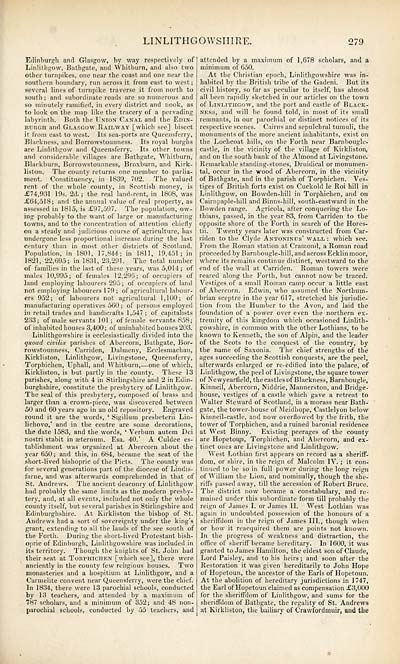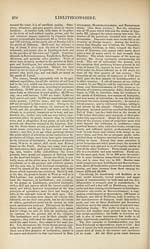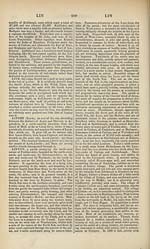Topographical, statistical, and historical gazetteer of Scotland > Volume 2
(293) Page 279
Download files
Complete book:
Individual page:
Thumbnail gallery: Grid view | List view

LINLITHGOWSHIRE.
279
Edinburgh and Glasgow, by way respectively of
Linlithgow, Bathgate, and Whitburn, and also two
other turnpikes, one near the coast and one near the
southern boundary, run across it from east to west ;
several lines of turnpike traverse it from north to
south ; and subordinate roads are so numerous and
so minutely ramified, in every district and nook, as
to look on the map like the tracery of a pervading
labyrinth. Both the Union Canal and the Edin-
burgh and Glasgow Railway [which see] bisect
it from east to west. Its sea-ports are Queensferry,
Blackness, and Borrowstounness. Its royal burghs
are Linlithgow and Queensferry. Its other towns
and considerable villages are Bathgate, Whitburn,
Blackburn, Borrowstounness, Broxburn, and Kirk-
liston. The county returns one member to parlia-
ment. Constituency, in 1839, 702. The valued
rent of the whole county, in Scottish money, is
£74,931 19s. 2d.; the real land-rent, in 1808, was
£64,518; and the annual value of real property, as
assessed in 1815, is £97,597. The population, ow-
ing probably to the Want of large or manufacturing
towns, and to the concentration of attention chiefly
on a steady and judicious course of agriculture, has
undergone less proportional increase during the last
century than in most other districts of Scotland.
Population, in 1S0I, 17,844; in 1811, 19,451; in
1821, 22,695; in 1831, 23,291. The total number
of families in the last of these years, was 5,014; of
males 10,995; of females 12,295; of occupiers of
land employing labourers 295; of occupiers of land
not employing labourers 1 79 ; of agricultural labour-
ers 952; of labourers not agricultural 1,100; of
manufacturing operatives 560; of persons employed
in retail trades and handicrafts 1,547 ; of capitalists
233; of male servants 101 ; of female servants 858;
of inhabited houses 3,400; of uninhabited houses 203.
Linlithgowshire is ecclesiastically divided into the
quoad civilia parishes of Abercorn, Bathgate, Bor-
rowstounness, Carriden, Dalmeny, Ecclesmachan,
Kirkliston, Linlithgow, Livingstone, Queensferry,
Torphichen, Uphall, and Whithurn, — one of which,
Kirkliston, is but partly in the county. These 13
parishes, along with 4 in Stirlingshire and 2 in Edin-
burghshire, constitute the presbytery of Linlithgow.
The seal of this presbytery, composed of brass and
larger than a crown-piece, was discovered between
50 and 60 years ago in an old repository. Engraved
round it are the words, ' Sigillum presbeterii Lin-
lichovo,' and in the centre are some decorations,
the date 1583, and the words, ' Verbum autem Dei
nostri stabit in asternum. Esa. 40.' A Culdee es-
tablishment was organized at Abercorn about the
year 650 ; and this, in 684, became the seat of the
short-lived bishopric of the Picts. The county was
for several generations part of the diocese of Lindis-
farne, and was afterwards comprehended in that of
St. Andrews. The ancient deaconry of Linlithgow
had probably the same limits as the modern presby-
tery, and, at all events, included not only the whole
county itself, but several parishes in Stirlingshire and
Edinburghshire. At Kirkliston the bishop of St.
Andrews had a sort of sovereignty under the king's
grant, extending to all the lauds of the see south of
the Forth. During the short-lived Protestant bish-
opric of Edinburgh, Linlithgowshire was included in
its territory. Though the knights of St. John had
their seat at Torphichen [which see], there were
anciently in the county few religious houses. Two
monasteries and a hospitiuni at Linlithgow, and a
Carmelite convent near Queensferry, were the chief.
In 1834, there were 13 parochial schools, conducted
by 13 teachers, and attended by a maximum of
787 scholars, and a minimum of 352; and 48 non-
parochial schools, conducted by 55 teachers, and
attended by a maximum of 1,678 scholars, and a
minimum of 650.
At the Christian epoch, Linlithgowshire was in-
habited by the British tribe of the Gadeni. But its
civil history, so far as peculiar to itself, has almost
all been rapidly sketched in our articles on the town
of Linlithgow, and the port and castle of Black-
ness, and will be found told, in most of its small
remnants, in our parochial or distinct notices of its
respective scenes. Cairns and sepulchral tumuli, the
monuments of the more ancient inhabitants, exist on
the Lochcoat hills, on the Forth near Barnbougle-
castle, in the vicinity of the village of Kirkliston,
and on the south bank of the Almond at Livingstone.
Remarkable standing-stones, Druidical or monumen-
tal, occur in the wood of Abercorn, in the vicinity
of Bathgate, and in the parish of Torphichen. Ves-
tiges of British forts exist on Cuckold le Roi hill in
Linlithgow, on Bowden-hill in Torphichen, and on
Cairnpaple-hill and Binns-hill, south-eastward in the
Bowden range. Agricola, after conquering the Lo-
thians, passed, in the year 83, from Carriden to the
opposite shore of the Forth in search of the Hores-
tii. Twenty years later was constructed from Car-
riden to the Clyde Antoninus' wall : which see.
From the Roman station at Cramond, a Roman road
proceeded by Barnbougle-hill, and across Ecklin moor,
where its remains continue distinct, westward to the
end of the wall at Carriden. Roman towers were
reared along the Forth, but cannot now be traced.
Vestiges of a small Roman camp occur a little east
of Abercorn. Edwin, who assumed the Northum-
brian sceptre in the year 617, stretched his jurisdic-
tion from the Humher to the Avon, and laid the
foundation of a power over even the northern ex-
tremity of this kingdom which occasioned Linlith-
gowshire, in common with the other Lothians, to be
known to Kenneth, the son of Alpin, and the leader
of the Scots to the conquest of the country, by
the name of Saxonia. The chief strengths of the
ages succeeding the Scottish conquests, are the peel,
afterwards enlarged or re-edified into the palace, of
Linlithgow, the peel of Livingstone, the square tower
of Newyearfield, the castles of Blackness, Barnbougle,
Kinneil, Abercorn, Niddrie, Mannerston, and Bridge-
house, vestiges of a castle which gave a retreat to
Walter Steward of Scotland, in a morass near Bath-
gate, the tower-house of Meidhope, Castlelyon below
Kinneil-castle, and now overflowed by the frith, the
tower of Torphichen, and a ruined baronial residence
at West Binny. Existing peerages of the county
are Hopetoun, Torphichen, and Abercorn, and ex-
tinct ones are Livingstone and Linlithgow.
West Lothian first appears on record as a sheriff-
dom, or shire, in the reign of Malcolm IV. ; it con-
tinued to be so in full power during the long reign
of William the Lion, and nominally, though the she-
riffs passed away, till the accession of Robert Bruce.
The district now became a constabulary, and re-
mained under this subordinate form till probably the
reign of James I. or James II. West Lothian was
again in undoubted possession of the honours of a
sheriffdom in the reign of James III., though when
or bow it reacquired them are points not known.
In the progress of weakness and distraction, the
office of sheriff became hereditary. In 1600, it was
granted to James Hamilton, the eldest son of Claude,
Lord Paisley, and to his heirs ; and soon after the
Restoration it was given hereditarily to John Hope
of Hopetoun, the ancestor of the Earls of Hopetoun.
At the abolition of hereditary jurisdictions in 1747,
the Earl of Hopetoun claimed as compensation £3,000
for the sheriffdom of Linlithgow, and sums for the
sheriffdom of Bathgate, the regality of St. Andrews
at Kirkliston, the bailiary of Crawfordmuir, and the
279
Edinburgh and Glasgow, by way respectively of
Linlithgow, Bathgate, and Whitburn, and also two
other turnpikes, one near the coast and one near the
southern boundary, run across it from east to west ;
several lines of turnpike traverse it from north to
south ; and subordinate roads are so numerous and
so minutely ramified, in every district and nook, as
to look on the map like the tracery of a pervading
labyrinth. Both the Union Canal and the Edin-
burgh and Glasgow Railway [which see] bisect
it from east to west. Its sea-ports are Queensferry,
Blackness, and Borrowstounness. Its royal burghs
are Linlithgow and Queensferry. Its other towns
and considerable villages are Bathgate, Whitburn,
Blackburn, Borrowstounness, Broxburn, and Kirk-
liston. The county returns one member to parlia-
ment. Constituency, in 1839, 702. The valued
rent of the whole county, in Scottish money, is
£74,931 19s. 2d.; the real land-rent, in 1808, was
£64,518; and the annual value of real property, as
assessed in 1815, is £97,597. The population, ow-
ing probably to the Want of large or manufacturing
towns, and to the concentration of attention chiefly
on a steady and judicious course of agriculture, has
undergone less proportional increase during the last
century than in most other districts of Scotland.
Population, in 1S0I, 17,844; in 1811, 19,451; in
1821, 22,695; in 1831, 23,291. The total number
of families in the last of these years, was 5,014; of
males 10,995; of females 12,295; of occupiers of
land employing labourers 295; of occupiers of land
not employing labourers 1 79 ; of agricultural labour-
ers 952; of labourers not agricultural 1,100; of
manufacturing operatives 560; of persons employed
in retail trades and handicrafts 1,547 ; of capitalists
233; of male servants 101 ; of female servants 858;
of inhabited houses 3,400; of uninhabited houses 203.
Linlithgowshire is ecclesiastically divided into the
quoad civilia parishes of Abercorn, Bathgate, Bor-
rowstounness, Carriden, Dalmeny, Ecclesmachan,
Kirkliston, Linlithgow, Livingstone, Queensferry,
Torphichen, Uphall, and Whithurn, — one of which,
Kirkliston, is but partly in the county. These 13
parishes, along with 4 in Stirlingshire and 2 in Edin-
burghshire, constitute the presbytery of Linlithgow.
The seal of this presbytery, composed of brass and
larger than a crown-piece, was discovered between
50 and 60 years ago in an old repository. Engraved
round it are the words, ' Sigillum presbeterii Lin-
lichovo,' and in the centre are some decorations,
the date 1583, and the words, ' Verbum autem Dei
nostri stabit in asternum. Esa. 40.' A Culdee es-
tablishment was organized at Abercorn about the
year 650 ; and this, in 684, became the seat of the
short-lived bishopric of the Picts. The county was
for several generations part of the diocese of Lindis-
farne, and was afterwards comprehended in that of
St. Andrews. The ancient deaconry of Linlithgow
had probably the same limits as the modern presby-
tery, and, at all events, included not only the whole
county itself, but several parishes in Stirlingshire and
Edinburghshire. At Kirkliston the bishop of St.
Andrews had a sort of sovereignty under the king's
grant, extending to all the lauds of the see south of
the Forth. During the short-lived Protestant bish-
opric of Edinburgh, Linlithgowshire was included in
its territory. Though the knights of St. John had
their seat at Torphichen [which see], there were
anciently in the county few religious houses. Two
monasteries and a hospitiuni at Linlithgow, and a
Carmelite convent near Queensferry, were the chief.
In 1834, there were 13 parochial schools, conducted
by 13 teachers, and attended by a maximum of
787 scholars, and a minimum of 352; and 48 non-
parochial schools, conducted by 55 teachers, and
attended by a maximum of 1,678 scholars, and a
minimum of 650.
At the Christian epoch, Linlithgowshire was in-
habited by the British tribe of the Gadeni. But its
civil history, so far as peculiar to itself, has almost
all been rapidly sketched in our articles on the town
of Linlithgow, and the port and castle of Black-
ness, and will be found told, in most of its small
remnants, in our parochial or distinct notices of its
respective scenes. Cairns and sepulchral tumuli, the
monuments of the more ancient inhabitants, exist on
the Lochcoat hills, on the Forth near Barnbougle-
castle, in the vicinity of the village of Kirkliston,
and on the south bank of the Almond at Livingstone.
Remarkable standing-stones, Druidical or monumen-
tal, occur in the wood of Abercorn, in the vicinity
of Bathgate, and in the parish of Torphichen. Ves-
tiges of British forts exist on Cuckold le Roi hill in
Linlithgow, on Bowden-hill in Torphichen, and on
Cairnpaple-hill and Binns-hill, south-eastward in the
Bowden range. Agricola, after conquering the Lo-
thians, passed, in the year 83, from Carriden to the
opposite shore of the Forth in search of the Hores-
tii. Twenty years later was constructed from Car-
riden to the Clyde Antoninus' wall : which see.
From the Roman station at Cramond, a Roman road
proceeded by Barnbougle-hill, and across Ecklin moor,
where its remains continue distinct, westward to the
end of the wall at Carriden. Roman towers were
reared along the Forth, but cannot now be traced.
Vestiges of a small Roman camp occur a little east
of Abercorn. Edwin, who assumed the Northum-
brian sceptre in the year 617, stretched his jurisdic-
tion from the Humher to the Avon, and laid the
foundation of a power over even the northern ex-
tremity of this kingdom which occasioned Linlith-
gowshire, in common with the other Lothians, to be
known to Kenneth, the son of Alpin, and the leader
of the Scots to the conquest of the country, by
the name of Saxonia. The chief strengths of the
ages succeeding the Scottish conquests, are the peel,
afterwards enlarged or re-edified into the palace, of
Linlithgow, the peel of Livingstone, the square tower
of Newyearfield, the castles of Blackness, Barnbougle,
Kinneil, Abercorn, Niddrie, Mannerston, and Bridge-
house, vestiges of a castle which gave a retreat to
Walter Steward of Scotland, in a morass near Bath-
gate, the tower-house of Meidhope, Castlelyon below
Kinneil-castle, and now overflowed by the frith, the
tower of Torphichen, and a ruined baronial residence
at West Binny. Existing peerages of the county
are Hopetoun, Torphichen, and Abercorn, and ex-
tinct ones are Livingstone and Linlithgow.
West Lothian first appears on record as a sheriff-
dom, or shire, in the reign of Malcolm IV. ; it con-
tinued to be so in full power during the long reign
of William the Lion, and nominally, though the she-
riffs passed away, till the accession of Robert Bruce.
The district now became a constabulary, and re-
mained under this subordinate form till probably the
reign of James I. or James II. West Lothian was
again in undoubted possession of the honours of a
sheriffdom in the reign of James III., though when
or bow it reacquired them are points not known.
In the progress of weakness and distraction, the
office of sheriff became hereditary. In 1600, it was
granted to James Hamilton, the eldest son of Claude,
Lord Paisley, and to his heirs ; and soon after the
Restoration it was given hereditarily to John Hope
of Hopetoun, the ancestor of the Earls of Hopetoun.
At the abolition of hereditary jurisdictions in 1747,
the Earl of Hopetoun claimed as compensation £3,000
for the sheriffdom of Linlithgow, and sums for the
sheriffdom of Bathgate, the regality of St. Andrews
at Kirkliston, the bailiary of Crawfordmuir, and the
Set display mode to: Large image | Transcription
Images and transcriptions on this page, including medium image downloads, may be used under the Creative Commons Attribution 4.0 International Licence unless otherwise stated. ![]()
| Gazetteers of Scotland, 1803-1901 > Topographical, statistical, and historical gazetteer of Scotland > Volume 2 > (293) Page 279 |
|---|
| Permanent URL | https://digital.nls.uk/97497479 |
|---|
| Description | Volume second. I-Z. |
|---|---|
| Attribution and copyright: |
|

